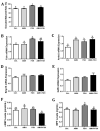Anti-Müllerian Hormone Inhibits FSH-Induced Cumulus Oocyte Complex In Vitro Maturation and Cumulus Expansion in Mice
- PMID: 35565634
- PMCID: PMC9103408
- DOI: 10.3390/ani12091209
Anti-Müllerian Hormone Inhibits FSH-Induced Cumulus Oocyte Complex In Vitro Maturation and Cumulus Expansion in Mice
Abstract
Anti-Müllerian hormone (AMH) is secreted by the ovaries of female animals and exerts its biological effects through the type II receptor (AMHR2). AMH regulates follicular growth by inhibiting the recruitment of primordial follicles and reducing the sensitivity of antral follicles to FSH. Despite the considerable research on the actions of AMH in granulosa cells, the effect of AMH on the in vitro maturation of oocytes remains largely unknown. In the current study, we showed that AMH is only expressed in cumulus cells, while AMHR2 is produced in both cumulus cells and oocytes. AMH had no significant effect on COCs nuclear maturation, whereas it inhibited the stimulatory effects of FSH on COCs maturation and cumulus expansion. Moreover, AMH treatment effectively inhibited the positive effect of FSH on the mRNA expressions of Hyaluronan synthase 2 (Has2), Pentraxin 3 (Ptx3), and TNF-alpha-induced protein 6 (Tnfaip 6) genes in COCs. In addition, AMH significantly decreased the FSH-stimulated progesterone production, but did not change estradiol levels. Taken together, our results suggest that AMH may inhibit the effects of FSH-induced COCs in vitro maturation and cumulus expansion. These findings increase our knowledge of the functional role of AMH in regulating folliculogenesis.
Keywords: anti-müllerian hormone; follicle-stimulating hormone; maturation; mice; oocyte.
Conflict of interest statement
The authors have no competing interest to declare.
Figures





Similar articles
-
Anti-Müllerian hormone promotes pre-antral follicle growth, but inhibits antral follicle maturation and dominant follicle selection in primates.Hum Reprod. 2016 Jul;31(7):1522-30. doi: 10.1093/humrep/dew100. Epub 2016 May 9. Hum Reprod. 2016. PMID: 27165618 Free PMC article.
-
Anti-Müllerian hormone is highly expressed and secreted from cumulus granulosa cells of stimulated preovulatory immature and atretic oocytes.Reprod Biomed Online. 2012 May;24(5):540-6. doi: 10.1016/j.rbmo.2012.01.023. Epub 2012 Jan 31. Reprod Biomed Online. 2012. PMID: 22421733
-
Recombinant anti-Müllerian hormone in the maturation medium improves the in vitro maturation of human immature (GV) oocytes after controlled ovarian hormonal stimulation.Reprod Biol Endocrinol. 2022 Jan 24;20(1):18. doi: 10.1186/s12958-022-00895-5. Reprod Biol Endocrinol. 2022. PMID: 35073905 Free PMC article.
-
Regulation of cumulus expansion and hyaluronan synthesis in porcine oocyte-cumulus complexes during in vitro maturation.Endocr Regul. 2012 Oct;46(4):225-35. doi: 10.4149/endo_2012_04_225. Endocr Regul. 2012. PMID: 23127506 Review.
-
Interactions between androgens, FSH, anti-Müllerian hormone and estradiol during folliculogenesis in the human normal and polycystic ovary.Hum Reprod Update. 2016 Nov;22(6):709-724. doi: 10.1093/humupd/dmw027. Epub 2016 Aug 27. Hum Reprod Update. 2016. PMID: 27566840 Review.
Cited by
-
Pre-pubertal oocytes harbor altered histone modifications and chromatin configuration.Front Cell Dev Biol. 2023 Jan 10;10:1060440. doi: 10.3389/fcell.2022.1060440. eCollection 2022. Front Cell Dev Biol. 2023. PMID: 36704200 Free PMC article.
-
Transcriptome Signature of Immature and In Vitro-Matured Equine Cumulus-Oocytes Complex.Int J Mol Sci. 2023 Sep 6;24(18):13718. doi: 10.3390/ijms241813718. Int J Mol Sci. 2023. PMID: 37762020 Free PMC article.
-
Unraveling the Clinical FSH Conundrum: Insights From the Small Ovarian Reserve Heifer Model.Mol Reprod Dev. 2025 Feb;92(2):e70007. doi: 10.1002/mrd.70007. Mol Reprod Dev. 2025. PMID: 39935023 Free PMC article. Review.
-
Reduced anti-Müllerian hormone action in cumulus-oocyte complexes is beneficial for oocyte maturation without affecting oocyte competence.Front Endocrinol (Lausanne). 2024 Jun 3;15:1365260. doi: 10.3389/fendo.2024.1365260. eCollection 2024. Front Endocrinol (Lausanne). 2024. PMID: 38887270 Free PMC article.
References
-
- Cate R.L., Mattaliano R.J., Hession C., Tizard R., Farber N.M., Cheung A., Ninfa E.G., Frey A.Z., Gash D.J., Chow E.P., et al. Isolation of the bovine and human genes for müllerian inhibiting substance and expression of the human gene in animal cells. Cell. 1986;45:685–698. doi: 10.1016/0092-8674(86)90783-X. - DOI - PubMed
Grants and funding
LinkOut - more resources
Full Text Sources
Miscellaneous

